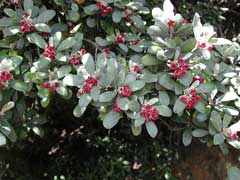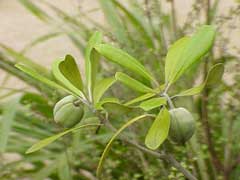 |
|
http://en.wikipedia.org/wiki/User:Pseudopanax |
 |
| biolib.de |
Translate this page:
Summary
Physical Characteristics

 Pittosporum crassifolium is an evergreen Shrub growing to 5 m (16ft) by 3 m (9ft).
Pittosporum crassifolium is an evergreen Shrub growing to 5 m (16ft) by 3 m (9ft).
See above for USDA hardiness. It is hardy to UK zone 9. It is in leaf all year, in flower in May. The species is monoecious (individual flowers are either male or female, but both sexes can be found on the same plant). The plant is self-fertile.
Suitable for: light (sandy) and medium (loamy) soils and prefers well-drained soil. Suitable pH: mildly acid, neutral and basic (mildly alkaline) soils. It can grow in semi-shade (light woodland) or no shade. It prefers dry or moist soil. The plant can tolerate maritime exposure.
UK Hardiness Map
US Hardiness Map
Synonyms
Plant Habitats
Woodland Garden Sunny Edge; Dappled Shade; Hedge;
Edible Uses
References More on Edible Uses
Medicinal Uses
Plants For A Future can not take any responsibility for any adverse effects from the use of plants. Always seek advice from a professional before using a plant medicinally.
None known
References More on Medicinal Uses
The Bookshop: Edible Plant Books
Our Latest books on Perennial Plants For Food Forests and Permaculture Gardens in paperback or digital formats.

Edible Tropical Plants
Food Forest Plants for Hotter Conditions: 250+ Plants For Tropical Food Forests & Permaculture Gardens.
More

Edible Temperate Plants
Plants for Your Food Forest: 500 Plants for Temperate Food Forests & Permaculture Gardens.
More

More Books
PFAF have eight books available in paperback and digital formats. Browse the shop for more information.
Shop Now
Other Uses
Dye Hedge Hedge Soap Soil stabilization Wood
A dark blue dye is obtained from the seeds[169]. The plant is a potential source of saponins. Saponins can be used to as a soap and, because of their bitter taste, they also have potential as a bird deterrent by spraying them over the plants. The bitterness can be easily removed by washing (or by the next rainfall!). Very tolerant of pruning and maritime exposure, this plant can be grown as a protective hedge by the coast in mild maritime areas[11, 29, 49, 75]. The plant has an extensive root system and can be used for binding sandy soils, dunes etc[153]. Wood - very tough. Used for inlay[46, 61].
Special Uses
Hedge Hedge Scented Plants
References More on Other Uses
Cultivation details
Succeeds in any well-drained soil[182, 200], including dry soils, preferably in a sunny position[182] but also succeeding in light shade[200]. Plants are very resistant to maritime exposure[11, 29, 75, 200]. This species is not very cold-hardy in Britain, succeeding outdoors only in the milder areas of the country[11]. Plants grow very well on the Scilly Isles but have not been proved on the mainland[29].Other reports say that it grows well in south-western England[11, 49]. Very amenable to pruning, plants can be cut right back into old wood if required[200]. The flowers are sweetly scented, they are borne in terminal clusters of either up to 10 males or up to 5 females[219]. Plants only flower freely in mild areas of the country[219]. The species in this genus are very likely to hybridize with other members of the genus[200]. When growing a species from seed it is important to ensure that the seed either comes from a known wild source, or from isolated specimens in cultivation. Plants in this genus are notably resistant to honey fungus[200].
References Carbon Farming Information and Carbon Sequestration Information
Temperature Converter
Type a value in the Celsius field to convert the value to Fahrenheit:
Fahrenheit:
The PFAF Bookshop
Plants For A Future have a number of books available in paperback and digital form. Book titles include Edible Plants, Edible Perennials, Edible Trees,Edible Shrubs, Woodland Gardening, and Temperate Food Forest Plants. Our new book is Food Forest Plants For Hotter Conditions (Tropical and Sub-Tropical).
Shop Now
Plant Propagation
Seed - sow when ripe in the autumn or in late winter in a warm greenhouse[78, 200]. The seed usually germinates freely. Prick out the seedlings into individual pots when they are large enough to handle, move the plants to a cold frame as soon as they are established and plant out late in the following spring[78]. Consider giving them some protection from the cold during their first winter outdoors. Cuttings of half-ripe wood, 5 - 7cm with a heel, July/August in a frame. Poor to fair percentage[78]. Basal ripewood cuttings late autumn in a cold frame[200].
Other Names
If available other names are mentioned here
Native Range
AUSTRALASIA: New Zealand (Kermadec Islands, North Island)
Weed Potential
Right plant wrong place. We are currently updating this section.
Please note that a plant may be invasive in one area but may not in your area so it's worth checking.
Conservation Status
IUCN Red List of Threatened Plants Status :

| Related Plants
|
| Latin Name | Common Name | Habit | Height | Hardiness | Growth | Soil | Shade | Moisture | Edible | Medicinal | Other |
| Pittosporum balansae | | Shrub | 3.0 |
-
| | LMH | SN | DM | 1 | 0 | |
| Pittosporum bicolor | Banyalla | Shrub | 5.0 |
8-11
| | LMH | SN | DM | 0 | 0 | 3 |
| Pittosporum eugenioides | Tarata | Tree | 10.0 |
8-11
| | LM | SN | DM | 1 | 1 | 1 |
| Pittosporum phillyreoides | Weeping Pittosporum, Narrow-leaf Pittosporum | Shrub | 4.5 |
9-11
| S | LM | N | DM | 2 | 1 | 2 |
| Pittosporum ralphii | Ralph's desertwillow | Shrub | 4.0 |
8-11
| | LM | N | DM | 0 | 0 | 3 |
| Pittosporum resiniferum | Petroleum nut | Tree | 25.0 |
10-12
| M | LMH | N | M | 0 | 3 | 4 |
| Pittosporum tenuifolium | Tawhiwhi | Tree | 7.0 |
7-10
| M | LM | SN | DM | 2 | 0 | 3 |
| Pittosporum tobira | Tobira, Japanese cheesewood, Australian Laurel, Mock Orange, Japanese Pittosporum | Shrub | 6.0 |
8-11
| F | LM | SN | DM | 0 | 0 | 3 |
| Pittosporum undulatum | Cheesewood, Australian cheesewood, Cheesewood, Pittosporum, Orange Berry Pittosporum, Victorian Box | Tree | 12.0 |
9-11
| F | LM | SN | DM | 0 | 0 | 3 |
|
Growth: S = slow M = medium F = fast. Soil: L = light (sandy) M = medium H = heavy (clay). pH: A = acid N = neutral B = basic (alkaline). Shade: F = full shade S = semi-shade N = no shade. Moisture: D = dry M = Moist We = wet Wa = water.
Now available:
Food Forest Plants for Mediterranean Conditions
350+ Perennial Plants For Mediterranean and Drier Food Forests and Permaculture Gardens.
[Paperback and eBook]
This is the third in Plants For A Future's series of plant guides for food forests tailored to
specific climate zones. Following volumes on temperate and tropical ecosystems, this book focuses
on species suited to Mediterranean conditions—regions with hot, dry summers and cool, wet winters,
often facing the added challenge of climate change.
Read More
Expert comment
Author
Banks.&Sol. ex A.Cunn.
Botanical References
1144200
Links / References
For a list of references used on this page please go here
Readers comment